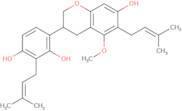
Product Information
- 1,3-Benzenediol, 4-[3,4-dihydro-7-hydroxy-5-methoxy-6-(3-methyl-2-butenyl)-2H-1-benzopyran-3-yl]-2-(3-methyl-2-butenyl)-, (R)-
- 1,3-Benzenediol, 4-[(3R)-3,4-dihydro-7-hydroxy-5-methoxy-6-(3-methyl-2-buten-1-yl)-2H-1-benzopyran-3-yl]-2-(3-methyl-2-buten-1-yl)-
- 2′,4′,5-Isoflavantriol, 7-methoxy-3′,6-bis(3-methyl-2-butenyl)-
- 4-[(3R)-3,4-Dihydro-7-hydroxy-5-methoxy-6-(3-methyl-2-buten-1-yl)-2H-1-benzopyran-3-yl]-2-(3-methyl-2-buten-1-yl)-1,3-benzenediol
- 1,3-Benzenediol, 4-[(3R)-3,4-dihydro-7-hydroxy-5-methoxy-6-(3-methyl-2-butenyl)-2H-1-benzopyran-3-yl]-2-(3-methyl-2-butenyl)-
Licoricidin is a licorice extract that is used as an anti-inflammatory and antiseptic. It has been shown to have a protective effect against oral pathogens, such as Candida albicans. Licoricidin also prevents the development of primary sclerosing cholangitis, which is a form of inflammatory bowel disease. The mechanism of action of licoricidin may be due to its inhibition of signal pathways and hydroxyl group. Licoricidin has been shown to inhibit colon cancer cells by causing apoptosis in colorectal adenocarcinoma cells. Licoricidin also inhibits the growth of cancer cells through the suppression of signal pathways, which may be due to its hydroxyl group.
Chemical properties
Technical inquiry about: 3D-FBA50827 Licoricidin
If you want to request a quotation or place an order, please instead add the desired products to your cart and then request a quotation or order from the cart. It is faster, cheaper, and you will be able to benefit from the available discounts and other advantages.





